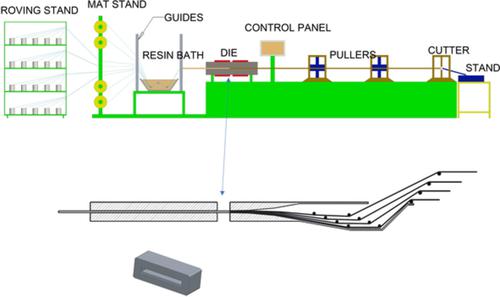当前位置:
X-MOL 学术
›
J. Appl. Polym. Sci.
›
论文详情
Our official English website, www.x-mol.net, welcomes your
feedback! (Note: you will need to create a separate account there.)
Determination of cure mechanism inside die for a part manufacturing during large-scale pultrusion
Journal of Applied Polymer Science ( IF 2.7 ) Pub Date : 2021-12-18 , DOI: 10.1002/app.52035 Arindam Mukherji 1 , Nozer Tarapore 1 , James Njuguna 2
Journal of Applied Polymer Science ( IF 2.7 ) Pub Date : 2021-12-18 , DOI: 10.1002/app.52035 Arindam Mukherji 1 , Nozer Tarapore 1 , James Njuguna 2
Affiliation

|
The cure kinetics of resin, heat capacity, and thermal conductivity of reinforcing materials of uncured mass dictate the ultimate curing of reinforced thermosets manufactured component. In this study, the degree of conversion from heat capacity by “Lumry and Eyring Model” and order of reaction by multi-regression technique using “Borchardt and Daniels Model” are calculated in finding cure kinetics ( ) of the resin. Experimental results from differential scanning calorimetry, thermogravimetry (TGA), and rheological measurements were used to determine thermal conductivity, heat capacity, and rheological parameters of the resin through several model fitting. The calculated thermal conductivity of uncured composite from ration of (length vs. contact area) and thermal resistivity extracted from TGA data was fitted into a specific mathematical model, which predicts the thermal behavior of heated prepreg during pultrusion operation. These parameters used in a separate mathematical partial differential equation-based model equation to predict the change in temperature and resin conversion along axial distance and radial thickness. The influence of operating conditions, such as rate of heating (early and late heating) and fiber volume fraction while curing inside die were calculated and validated with experimental results. This study evaluates the extent of heat transfer and degree of conversion inside pultrusion die during scale up steady state process. It is observed that the paradigm of influencing parameters like pulling speed, die radial thickness and heater engagement (early and late heating) on heat flow from die wall to core (i.e., thickness of the part being pulled) follows the data captured experimentally.
) of the resin. Experimental results from differential scanning calorimetry, thermogravimetry (TGA), and rheological measurements were used to determine thermal conductivity, heat capacity, and rheological parameters of the resin through several model fitting. The calculated thermal conductivity of uncured composite from ration of (length vs. contact area) and thermal resistivity extracted from TGA data was fitted into a specific mathematical model, which predicts the thermal behavior of heated prepreg during pultrusion operation. These parameters used in a separate mathematical partial differential equation-based model equation to predict the change in temperature and resin conversion along axial distance and radial thickness. The influence of operating conditions, such as rate of heating (early and late heating) and fiber volume fraction while curing inside die were calculated and validated with experimental results. This study evaluates the extent of heat transfer and degree of conversion inside pultrusion die during scale up steady state process. It is observed that the paradigm of influencing parameters like pulling speed, die radial thickness and heater engagement (early and late heating) on heat flow from die wall to core (i.e., thickness of the part being pulled) follows the data captured experimentally.
中文翻译:

大型拉挤成型零件制造模具内固化机理的确定
树脂的固化动力学、热容量和未固化质量的增强材料的热导率决定了增强热固性材料制造部件的最终固化。在这项研究中,通过“Lumry 和 Eyring 模型”从热容量转换的程度和使用“Borchardt 和 Daniels 模型”的多元回归技术计算反应级数,以找到固化动力学 ( ) 的树脂。差示扫描量热法、热重分析法 (TGA) 和流变测量的实验结果用于通过几个模型拟合确定树脂的热导率、热容量和流变参数。从 TGA 数据中提取的(长度与接触面积)比和热阻率计算的未固化复合材料的热导率被拟合到特定的数学模型中,该模型预测了加热预浸料在拉挤操作过程中的热行为。这些参数在一个单独的基于数学偏微分方程的模型方程中使用,以预测温度和树脂转化沿轴向距离和径向厚度的变化。操作条件的影响,计算了模具内固化时的加热速率(早期和晚期加热)和纤维体积分数,并通过实验结果进行了验证。本研究评估了放大稳态过程中拉挤模具内部的传热程度和转化程度。据观察,影响参数的范例,如拉制速度、模具径向厚度和加热器接合(早期和后期加热)对从模具壁到芯的热流(即,被拉制零件的厚度)遵循实验捕获的数据。
) 的树脂。差示扫描量热法、热重分析法 (TGA) 和流变测量的实验结果用于通过几个模型拟合确定树脂的热导率、热容量和流变参数。从 TGA 数据中提取的(长度与接触面积)比和热阻率计算的未固化复合材料的热导率被拟合到特定的数学模型中,该模型预测了加热预浸料在拉挤操作过程中的热行为。这些参数在一个单独的基于数学偏微分方程的模型方程中使用,以预测温度和树脂转化沿轴向距离和径向厚度的变化。操作条件的影响,计算了模具内固化时的加热速率(早期和晚期加热)和纤维体积分数,并通过实验结果进行了验证。本研究评估了放大稳态过程中拉挤模具内部的传热程度和转化程度。据观察,影响参数的范例,如拉制速度、模具径向厚度和加热器接合(早期和后期加热)对从模具壁到芯的热流(即,被拉制零件的厚度)遵循实验捕获的数据。
更新日期:2021-12-18
 ) of the resin. Experimental results from differential scanning calorimetry, thermogravimetry (TGA), and rheological measurements were used to determine thermal conductivity, heat capacity, and rheological parameters of the resin through several model fitting. The calculated thermal conductivity of uncured composite from ration of (length vs. contact area) and thermal resistivity extracted from TGA data was fitted into a specific mathematical model, which predicts the thermal behavior of heated prepreg during pultrusion operation. These parameters used in a separate mathematical partial differential equation-based model equation to predict the change in temperature and resin conversion along axial distance and radial thickness. The influence of operating conditions, such as rate of heating (early and late heating) and fiber volume fraction while curing inside die were calculated and validated with experimental results. This study evaluates the extent of heat transfer and degree of conversion inside pultrusion die during scale up steady state process. It is observed that the paradigm of influencing parameters like pulling speed, die radial thickness and heater engagement (early and late heating) on heat flow from die wall to core (i.e., thickness of the part being pulled) follows the data captured experimentally.
) of the resin. Experimental results from differential scanning calorimetry, thermogravimetry (TGA), and rheological measurements were used to determine thermal conductivity, heat capacity, and rheological parameters of the resin through several model fitting. The calculated thermal conductivity of uncured composite from ration of (length vs. contact area) and thermal resistivity extracted from TGA data was fitted into a specific mathematical model, which predicts the thermal behavior of heated prepreg during pultrusion operation. These parameters used in a separate mathematical partial differential equation-based model equation to predict the change in temperature and resin conversion along axial distance and radial thickness. The influence of operating conditions, such as rate of heating (early and late heating) and fiber volume fraction while curing inside die were calculated and validated with experimental results. This study evaluates the extent of heat transfer and degree of conversion inside pultrusion die during scale up steady state process. It is observed that the paradigm of influencing parameters like pulling speed, die radial thickness and heater engagement (early and late heating) on heat flow from die wall to core (i.e., thickness of the part being pulled) follows the data captured experimentally.
中文翻译:

大型拉挤成型零件制造模具内固化机理的确定
树脂的固化动力学、热容量和未固化质量的增强材料的热导率决定了增强热固性材料制造部件的最终固化。在这项研究中,通过“Lumry 和 Eyring 模型”从热容量转换的程度和使用“Borchardt 和 Daniels 模型”的多元回归技术计算反应级数,以找到固化动力学 (
 ) 的树脂。差示扫描量热法、热重分析法 (TGA) 和流变测量的实验结果用于通过几个模型拟合确定树脂的热导率、热容量和流变参数。从 TGA 数据中提取的(长度与接触面积)比和热阻率计算的未固化复合材料的热导率被拟合到特定的数学模型中,该模型预测了加热预浸料在拉挤操作过程中的热行为。这些参数在一个单独的基于数学偏微分方程的模型方程中使用,以预测温度和树脂转化沿轴向距离和径向厚度的变化。操作条件的影响,计算了模具内固化时的加热速率(早期和晚期加热)和纤维体积分数,并通过实验结果进行了验证。本研究评估了放大稳态过程中拉挤模具内部的传热程度和转化程度。据观察,影响参数的范例,如拉制速度、模具径向厚度和加热器接合(早期和后期加热)对从模具壁到芯的热流(即,被拉制零件的厚度)遵循实验捕获的数据。
) 的树脂。差示扫描量热法、热重分析法 (TGA) 和流变测量的实验结果用于通过几个模型拟合确定树脂的热导率、热容量和流变参数。从 TGA 数据中提取的(长度与接触面积)比和热阻率计算的未固化复合材料的热导率被拟合到特定的数学模型中,该模型预测了加热预浸料在拉挤操作过程中的热行为。这些参数在一个单独的基于数学偏微分方程的模型方程中使用,以预测温度和树脂转化沿轴向距离和径向厚度的变化。操作条件的影响,计算了模具内固化时的加热速率(早期和晚期加热)和纤维体积分数,并通过实验结果进行了验证。本研究评估了放大稳态过程中拉挤模具内部的传热程度和转化程度。据观察,影响参数的范例,如拉制速度、模具径向厚度和加热器接合(早期和后期加热)对从模具壁到芯的热流(即,被拉制零件的厚度)遵循实验捕获的数据。

































 京公网安备 11010802027423号
京公网安备 11010802027423号